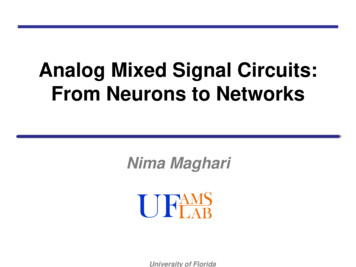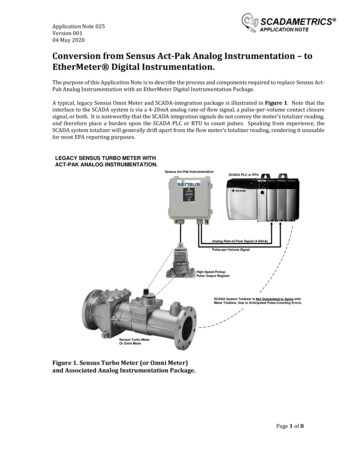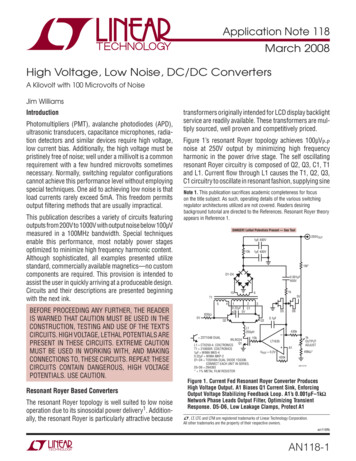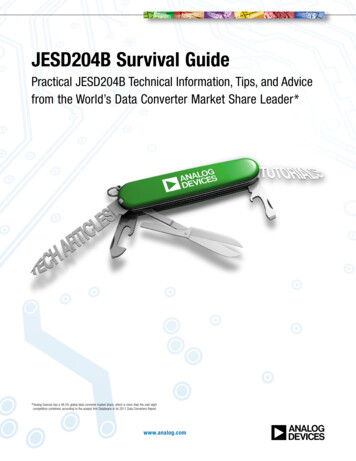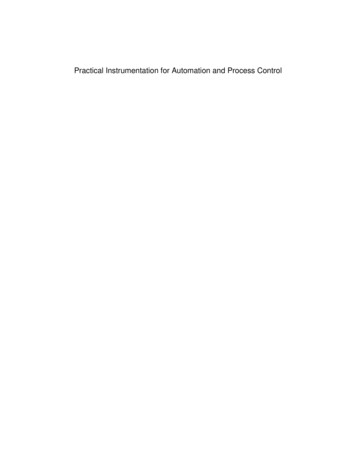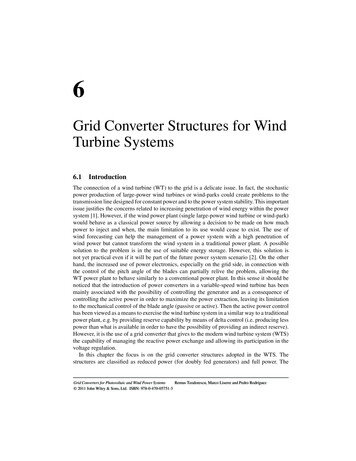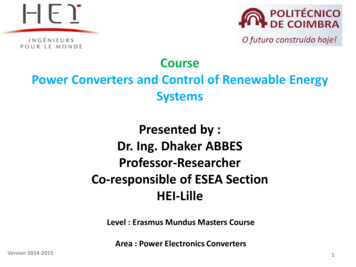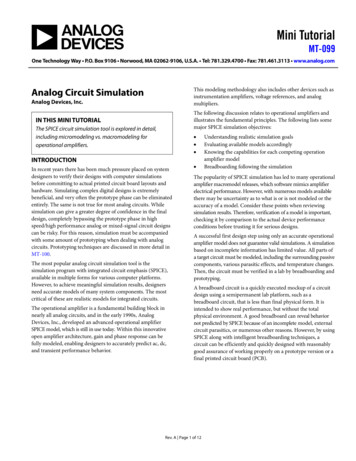
Transcription
AD779x Instrumentation ConvertersFrequently Asked QuestionsGeneral FAQsWhat are the advantages and disadvantages of -𝚫 ADCs?The penalty paid for the high resolution achievable with - technologyhas always been speed. The hardware has to operate at the oversampledrate, which is much larger than the maximum signal bandwidth, thusdemanding great complexity of the digital circuitry. Because of thislimitation, - converters have traditionally been relegated to highresolution, very low frequency applications and more recently speech,audio, and medium speeds (100 kHz to 1 MHz).The digital filtering stage results in long latency between the start ofthe sampling cycle and the first valid digital output; similarly, there is asignificant lag thereafter between digital outputs and their correspondingsampling instants. These characteristics reduce the throughput time inmultiplexed systems, as it takes many clock cycles for the digital filter tosettle after switching from one channel to the next.Most of the circuitry in Σ-Δ converters is digital, allowing theseconverters to be fabricated on a wide range of IC processes. This impliesthat performance will not drift significantly with time and temperature.They are inherently monotonic (that is, a change in the digital outputalways has the same slope as the analog input). This is of particularimportance in closed-loop control systems where misinterpretation ofthe direction of change of a measured variable may cause the system tobecome unstable. They are inherently linear and present little differentialnonlinearity. External sample-and-hold circuits are not required due tothe high input sampling rate and low precision of the analog-to-digitalconversion in the modulator (the devices are inherently self-sampling andtracking). Requirements for analog antialiasing filters are minimum—inmost cases, a simple single-pole RC filter suffices, as the bandwidth ofinterest is considerably lower than the first image that occurs about themodulator frequency. In contrast, the filters required for medium to highresolution applications using other (nonoversampling) technologies arevery sophisticated, difficult to design, large, and expensive.What are the main applications?These devices provide a complete analog front end for low frequencymeasurement applications. These applications include portableinstrumentation, process control, smart transmitters, weigh scale, andtransducer-based applications, as well as temperature and pressuremeasurement systems. In pressure and temperature measurementsystems, for example, the system designer is faced with the task ofmeasuring small signals that are generated from pressure sensors, RTDs(resistance temperature detectors), or thermocouples and resolving theseto resolutions of 16 bits or higher. The major design tasks include signalconditioning of the output signal from the transducer, processing thesignal to achieve the required resolution and accuracy, and ensuring thatpower consumption is low enough for portable applications. This family ofΣ-Δ converters consists of fully integrated solutions that incorporate therequired signal conditioning, filtering, and an analog-to-digital converteronto a single chip, allowing direct transducer interface without the needfor front-end signal conditioning. The AD779x family consists of 16-bit and24-bit resolution ADCs, which have a power consumption of typically 2 mW,making them ideal choices for portable data acquisition applications.What is the traditional approach to analog front-end solutions, andhow do Σ-Δ solutions overcome their shortcomings?Traditional approaches to the problem of measuring signals fromtransducers have used a high resolution analog-to-digital converter (ADC)as the core element in the process. These were generally integrating ADCsor voltage-to-frequency converters (VFC) that provided high resolution forlow input bandwidth signals. This type of ADC had to be surrounded by aconsiderable amount of analog signal conditioning circuitry to boost thetransducer output signal so that the full dynamic range of these converterscould be used to achieve the required performance. The performance ofthis signal conditioning circuitry, rather than the high resolution converter,often determined the system success in measuring low level signals.In designing gain stages, a number of factors have to be taken intoaccount; the first and most critical is noise, both in the measurementenvironment and in the components that constitute the high gainstage. Common sources of noise in the circuit design environmentare mains frequency noise and power supply noise. Other causes forconcern include common-mode rejection of the gain stage, as thetransducer output may sit on a large dc signal, therefore necessitatingconversion from a differential input signal to a single-ended output.Offset in the amplifiers along with drift performance play havoc withcircuit performance, leading to the use of expensive chopper stabilizedamplifiers. Programmability was difficult to design into these systems,and calibration was performed mainly with the use of the systemmicrocontroller. This leads to the requirement for external memory tostore calibration coefficients.Advances in design have enabled low cost, low power, highly accurate,integrated solutions to be developed. These architectures address thereal-world problems of low power design required for data acquisitionapplications. The advantages that an integrated solution offers the systemdesigner includes signal conditioning necessary for direct transducerinterface integrated on chip to greatly reduce analog circuit designand layout complexity. Integrated solutions also offer better control ofspecifications and error budgets than those of discrete solutions. - converters provide enough dynamic range to allow direct transducerinterface, thus removing the need for a high gain signal conditioning stagein front of the ADC.The data sheet mentions that large external capacitors between theinput and ground can affect measurement accuracy in unbufferedmode. Can you explain why this is the case? Does it only affect acinput signals, or are dc input signals affected, too?If you use the ADC in unbuffered mode, large RC constants on the inputcan interact with the internal sampling capacitor and effectively starvewww.analog.com/sigma delta
the sampling capacitor of charging current. This will cause gain errors inthe ADC. The solution is either to use buffered mode or ensure that yourespect the maximum RC values given in the data sheet.The reference inputs are also unbuffered so, as with using the analoginputs in unbuffered mode, the RC loading on the reference inputs mustbe sufficiently low to avoid introducing errors into the conversion process.The AD7792/AD7793/AD7794 can use an external clock. What is thefrequency range of the external clock?Although the on-chip 64 kHz clock is used by most customers, the AD7792/AD7793/AD7794 have the capability of being driven from an external clock.The parts can use an external clock from 60 kHz to 70 kHz and still meetthe data sheet specifications. While the part continues to function withclock frequencies outside this range, performance is not guaranteed.What is the output data update rate when the AD7792/AD7793/AD7794are used with a master clock other than 64 kHz?The devices have 16 selectable output rates from 4.17 Hz to 470 Hz.These values are determined by the internal clock. When the master clockfrequency is changed, the output data rate will scale with the appliedclock. For example, the default output data rate equals 16.7 Hz when themaster clock is 64 kHz. If the master clock is reduced to 60 kHz, then theoutput data rate is reduced to (60/64) 16.7 15.66 Hz.Changing the output data rate will also affect the filter notches. Whenthe output data rate equals 16.7 Hz, there are notches placed at 50 Hzand 60 Hz. If the master clock frequency is reduced to 60 kHz, the 50 Hznotch is moved to 46.87 Hz and the 60 Hz notch is moved to 56.25 Hz.The ADC is seeing overvoltages in my application. How can I protectthe ADC against these overvoltages?The analog input pins can tolerate a voltage between GND – 0.3 V andAVDD 0.3 V. There are ESD diodes connected from each analog inputto AVDD and from each analog input to GND. If an overvoltage is seenon the analog input (a voltage that is in excess of 500 mV outside thepower supply rails), these diodes will turn. These ESD diodes provide alow resistance path so the overvoltage is directed away from the ADC’smodulator. However, the ESD diodes can only tolerate a continuouscurrent less than 10 mA. So, to prevent damage of the ADC, some externalresistance is required so that the current is limited to less than 10 mA.Using external limiting resistors prevents the ADC from gettingdamaged. However, the external overvoltage may cause the on-chipregisters to be corrupted.To prevent the internal registers from being corrupted, the overvoltageneeds to be directed away from the ADC. Connecting Schottky diodesfrom each analog input to AVDD and GND is one method that can be used.The Schottky diode must have a turn-on voltage of 300 mV. This ensuresthat the external diode turns on before the ADC’s internal diodes so thatthe overvoltage is directed away from the ADC. Since the ADC does notexperience any overvoltage, the on-chip registers will remain intact.Are there any suggested protection schemes against ESD that shouldbe considered with these products?These converters are manufactured on a standard CMOS process;therefore, all standard practices and protection schemes apply to thesedevices as with all other CMOS devices. There are ESD protection diodeson all the inputs that protect the device from possible ESD hits due tohandling and production. These ESD protection diodes will act to clampthe voltage at any pin to within 0.5 V of the supplies. They can carry quitehigh currents but only for a short period of time; thus, they can protectthe IC from large pulses of short duration (the total energy is still quitelow). The latchup current is typically 100 mA on all pins.2 AD779x Instrumentation ConvertersThe maximum dc current that these protection diodes can withstand is10 mA. Therefore, the maximum current that can be applied to any inputis 10 mA. If it is possible for a current in excess of 10 mA to be appliedto a pin due to an overvoltage, external protection is required. Protectionschemes that can be applied include transzorbs on the power supply lines,series resistors on digital input lines, and resistors and diodes on analoginputs. For example, the external protection could be a resistor in serieswith the input pin to limit the current into the pin to less than 10 mA. Forexample, if the maximum overvoltage applied to a pin will be 5 V, a 1 kΩseries resistor in each line will limit the current to 5 mA.There are a number of application notes and seminar material availableon this topic. These are available on www.analog.com:AN-202 Application Note, An IC Amplifier User’s Guide to Decoupling,Grounding, and Making Things Go Right for a Change.www.analog.com/AN-202.AN-311 Application Note, How to Reliably Protect CMOS CircuitsAgainst Power Supply Overvoltage. www.analog.com/AN-311.AN-397 Application Note, Electrically Induced Damage to Standard LinearIntegrated Circuits. www.analog.com/AN-397.Overvoltage Effects on Analog ICs. www.analog.com/overvoltage section7.What about susceptibility to conducted and radiated electromagneticemissions?Any Σ-Δ ADC will be susceptible to conducted RF into the inputs, thepower supply pins, or the reference. The reason is that spurious RFsignals and their harmonics can be averaged by the Σ-Δ modulator andshow up as a dc offset or an increase in the noise floor. Radiated RF is alittle more difficult to discuss, but similar problems can occur and thereare situations where it is necessary to shield the Σ-Δ ADC in a systemfrom large RF fields generated locally within the system.The amount of protection required will depend on the strength of thelocal field. There are no hard and fast rules when designing for EMCcompatibility as every system will be different. However, there are generalguidelines that can be followed: Consider the inputs, reference, and power supply pins and ensure that eachof these lines is properly filtered up to the required maximum frequency. Decoupling capacitors on the power supply, mounted locally to the IC,possibly a small inductor between the analog and digital supplies. Filtering on the reference and the inputs is also critical. A solid low impedance ground plane and separation of the analog anddigital grounds.These are all the usual good practices with the ground plane running underthe whole of the IC. The evaluation board provides a good starting point.Occasionally, it is necessary to provide a Faraday shield for an ADC if thepart is operating in the presence of high EM fields such as next to a powersupply or relay or RF transmitter. However, this is an exceptional case.As a component manufacturer, Analog Devices does not perform EMCtesting as a general rule since EMC is a system level specificationrather than a component specification. It is the responsibility of the PCBdesigner to ensure that sensitive parts of the circuitry are protected fromspurious signals. We don’t have guaranteed bulletproof EMC design thatwe can give to customers, but if you use the evaluation board and followstandard practices for layout, grounding, and decoupling, it is possible todesign a system that meets the CE mark and beyond without expendingtoo much design effort. The final chapter in all our seminar books isdedicated to hardware design techniques and deals with such issues as
grounding, decoupling, parasitic thermocouples, and good PCB design.www.analog.com/hardware designtech sec10.Analog Performance FAQsHow is the programmable gain function implemented?The AD779x uses an instrumentation amplifier to implement the gainstage when the gain is set between 4 and 128. For a gain of 2, the gainis implemented capacitively (the reference capacitor in the modulator ishalved). An instrumentation amplifier was used for the higher gains, as itconsumes less power than a capacitive PGA.The data sheet mentions that the analog input of the ADC can acceptbipolar inputs of 30 mV centered around 0 V when the buffer is notused. Can a 3 V/5 V single supply part really do this?Yes! Each analog input has ESD diodes from the pin to AVDD and to GND.The input stage is truly differential; in theory, it can tolerate negative inputvoltages. However, leakage through the ESD protection diodes limits theability to handle negative voltages. The diodes will turn on when the voltageacross them is 300 mV approximately. This turn-on voltage is temperaturedependent. The effect of leakage through these diodes is to increase thenoise at the input and, hence, reduce the overall resolution. Analog Devicesguarantees full data sheet performance for analog inputs of 30 mV overthe full specified temperature range (gain 1 or 2, and buffer disabled).What voltage is within specifications on the analog input pins?The analog input pins can tolerate a voltage from GND – 30 mV toAVDD 30 mV when the gain is equal to 1 or 2 and the buffer isdisabled. When the buffer is enabled, the buffer itself will requiresome headroom. The absolute voltage on the analog input pins mustbe between GND 100 mV and AVDD – 100 mV. The buffer will benonlinear outside this range, so the device will be unable to meet thedata sheet specifications. When the in-amp is enabled (gains of 4 orhigher), the in-amp itself requires some headroom. Hence, the absolutevoltage on an analog input pin is now limited to GND 300 mV andAVDD – 1.1 V. If the analog input is outside this range, the ADC willfunction; but the part will not meet the data sheet specifications, as thein-amp is nonlinear near the power supply rails.The ADC is seeing overvoltages in my application.How can I protect the ADC against these overvoltages?The analog input pins can tolerate a voltage between GND – 0.3 V andAVDD 0.3 V. There are ESD diodes connected from each analog inputto AVDD, and from each analog input to GND. If an overvoltage is seenon the analog input (a voltage that is in excess of 500 mV outside thepower supply rails), these diodes will turn. These ESD diodes provide alow resistance path so the overvoltage is directed away from the ADC’smodulator. However, the ESD diodes can only tolerate a continuouscurrent less than 10 mA. To prevent damage of the ADC, some externalresistance is required so the current is limited to less than 10 mA.Using external limiting resistors prevents the ADC from gettingdamaged. However, the external overvoltage may cause the on-chipregisters to be corrupted.To prevent the internal registers from being corrupted, the overvoltageneeds to be directed away from the ADC. Connecting Schottky diodesfrom each analog input to AVDD and GND is one method that can beused. The Schottky diode must have a turn-on voltage of 300 mV. Thisensures that the external diode turns on before the ADC’s internal diodesso the overvoltage is directed away from the ADC. Since the ADC does notexperience any overvoltage, the on-chip registers will remain intact.When the ADC is operated with the inputs shorted, different outputcodes are obtained depending on whether the part is operated inbuffered or unbuffered mode. Is this normal?If an internal offset and gain calibration is performed when the buffer isselected or deselected, the same code should be obtained from the ADCin both buffered and unbuffered mode within the noise limit of the part. Ifa calibration is not performed, it is quite possible to see a different outputcode in buffered and unbuffered mode for the same input voltage. Thebuffer is similar to an operational amplifier; therefore, it will have an offsetvoltage. When the user switches between buffered and unbuffered mode, acalibration is essential to remove this offset.It is important to remember that a calibration must be performed wheneverthe filter word, input range, or the mode of the buffer is changed. The datasheet includes noise tables that list the expected noise and code spread forthe various operating conditions.I’m measuring the input leakage current in unbuffered mode. It issignificantly higher than the value specified in the data sheet. Why is this?Static leakage current is specified in the data sheet. The dynamic leakagecurrent (the leakage current when the ADC is converting) is not specified.If you put the ADC into unbuffered mode and measure the input current,you will observe a combination of leakage current and the dynamiccurrent charging and discharging the sampling capacitor. If the dynamiccharging current is likely to be a problem in your application (for example,if you have a high source impedance) you can use the on-chip buffer toisolate the input from these dynamic charging currents. However, thiswill result in reduced input common-mode voltage. The buffer inputcommon-mode range is 1.1 V below VDD and 300 mV above AGNDcompared to a common-mode range of 30 mV above VDD and 30 mVbelow AGND for unbuffered mode.The data sheet mentions that large external capacitors between theinput and ground can affect measurement accuracy in unbufferedmode. Can you explain why this is the case? Does it only affect acinput signals, or are dc input signals affected too?If you use the ADC in unbuffered mode, large RC constants on the inputcan interact with the internal sampling capacitor and effectively starvethe sampling capacitor of charging current. This will cause gain errors inthe ADC. The solution is either to use buffered mode or ensure that yourespect the maximum RC values given in the data sheet.The reference inputs are also unbuffered; as with using the analog inputsin unbuffered mode, the RC loading on the reference inputs must besufficiently low to avoid introducing errors into the conversion process.How does switching between channels affect throughput?The output data rate, which is listed in the data sheet, is the rate atwhich valid conversions are available when continuous conversionsare being performed on a single channel. When the user switches toanother channel, additional time is required for the Σ-Δ modulator anddigital filter to settle. The settling time associated with these convertersis the time it takes the output data to reflect the input voltage followinga channel change. To accurately reflect the analog input following achannel change, the digital filter must be flushed of all data pertaining tothe previous analog input. With the AD779x parts, it takes two times theprogrammed output data rate (conversion time) to clear the filter due tochopping. Therefore, if the output data rate is 16.6 Hz, for example, thetime required to generate a valid conversion after switching channelsequals [1/(2 16.6 Hz)].When a channel change occurs, the digital filter and modulator areautomatically reset; DRDY goes high and will remain high until a validconversion is available from the new analog input channel. Therefore,www.analog.com/sigma delta 3
following a channel change, DRDY will remain high until the digital filterhas calculated a valid conversion (that is, it will remain high for twoconversion cycles).When a step change occurs (on the analog input channel being converted),the ADC is not reset. The ADC continues to output conversions, and DRDYcontinues to pulse when a conversion is valid. However, the conversionswill not be valid, as the digital filter will require two conversion periodsto generate a digital word relevant to the altered analog input. If the stepchange occurs at the beginning of a conversion cycle, the ADC will output avalid word two conversion cycles later. However, if the step change occursasynchronously so that it occurs in the middle of a conversion, the ADCneeds to complete the present conversion and then perform two moreconversions to generate an output valid to the new analog input. Therefore,it may take three conversion cycles from the instant at which the stepchange occurs to the instant at which a valid conversion is available.In summary, the channel switching speed is one half the data output rate.Therefore, in switching applications, such as data acquisition systems,it is important to realize that the rate at which conversions are availableis two times less than the output data rate achieved when continuouslysampling a single channel.With the AD7794 and AD7795, chopping can be disabled. With choppingdisabled, the settling time is equal to the conversion time. So, the ADCoperates as a zero-latency ADC when chopping is disabled. Therefore, whenswitching between channels, a conversion will be available at 1/output datarate after the channel change.What is the ESD rating for the AD779x?The AD779x pass 1.5 kV (human body model) and pass 250 V (FICDM model).Are there any suggested protection schemes against ESD that shouldbe considered with these products?These converters are manufactured on a standard CMOS process;therefore, all standard practices and protection schemes apply to thesedevices as with all other CMOS devices. There are ESD protection diodeson all the inputs that protect the device from possible ESD hits due tohandling and production. These ESD protection diodes will act to clampthe voltage at any pin to within 0.5 V of the supplies. They can carry quitehigh currents but only for a short period of time; thus, they can protectthe IC from large pulses of short duration (the total energy is still quitelow). The latchup current is typically 100 mA on all pins.The maximum dc current that these protection diodes can withstand is10 mA. Therefore, the maximum current that can be applied to any inputis 10 mA. If it is possible for a current in excess of 10 mA to be appliedto a pin due to an overvoltage, external protection is required. Protectionschemes that can be applied include transzorbs on the power supply lines,series resistors on digital input lines, and resistors and diodes on analoginputs. For example, the external protection could be a resistor in serieswith the input pin to limit the current into the pin to less than 10 mA. Forexample, if the maximum overvoltage applied to a pin will be 5 V, a 1 kΩseries resistor in each line will limit the current to 5 mA.There are a number of application notes and seminar materials availableon this topic. These are available on www.analog.com:AN-202 Application Note, An IC Amplifier User’s Guide to Decoupling,Grounding, and Making Things Go Right for a Change.www.analog.com/AN-202.4 AD779x Instrumentation ConvertersAN-311 Application Note, How to Reliably Protect CMOS CircuitsAgainst Power Supply Overvoltage. www.analog.com/AN-311.AN-397 Application Note, Electrically Induced Damage to Standard LinearIntegrated Circuits. www.analog.com/AN-397.Overvoltage Effects on Analog ICs. www.analog.com/overvoltage section7.What about susceptibility to conducted and radiatedelectromagnetic emissions?Any Σ-Δ ADC will be susceptible to conducted RF into the inputs, the powersupply pins, or into the reference. The reason is that spurious RF signalsand their harmonics can be averaged by the Σ-Δ modulator and show upas a dc offset or an increase in the noise floor. Radiated RF is a little moredifficult to discuss, but similar problems can occur; there are situationswhere it is necessary to shield the Σ-Δ ADC in a system from large RFfields generated locally within the system.The amount of protection required will depend on the strength of thelocal field. There are no hard and fast rules when designing for EMCcompatibility as every system will be different. However, there are generalguidelines that can be followed: Consider the inputs, reference, and power supply pins and ensurethat each of these lines is properly filtered up to the requiredmaximum frequency. Decoupling capacitors on the power supply, mounted locally to the IC,possibly a small inductor between the analog and digital supplies. Filtering on the reference and the inputs is also critical. A solid low impedance ground plane and separation of the analog anddigital grounds.These are all the usual good practices with the ground plane running underthe whole of the IC. The evaluation board provides a good starting point.Occasionally, it is necessary to provide a Faraday shield for an ADC if thepart is operating in the presence of high EM fields such as next to a powersupply or relay or RF transmitter. However, this is an exceptional case.As a component manufacturer, Analog Devices does not perform EMCtesting as a general rule since EMC is a system level specification ratherthan a component specification. It is the responsibility of the PCB designerto ensure that sensitive parts of the circuitry are protected from spurioussignals. We don’t have guaranteed bulletproof EMC designs that we cangive to customers; but if you use the evaluation board and follow standardpractices for layout, grounding, and decoupling, it is possible to design asystem that meets the CE mark and beyond without expending too muchdesign effort. The final chapter in all our seminar books is dedicated tohardware design techniques and deals with such issues as grounding,decoupling, parasitic thermocouples, and good PCB design.www.analog.com/hardware designtech sec10.Explain the converter noise with respect to the noise tables in the datasheet and the sources of this noise.The noise tables in the data sheet show the output rms noise for theselectable output data rate for the part. The numbers given are for thebipolar input ranges with a specified reference and VDD supply used. Thesenoise numbers are typical and are generated at an analog input voltage of0 V, based on 1000 conversion results at the specified output data rate. Therms noise numbers are also converted to effective resolution in bits. Thesenumbers can be represented as effective resolution in bits rms or bits
peak-to-peak. Effective resolution in bits rms is defined as the magnitudeof the output rms noise with respect to the input full scale (2 VREF/gain). Itis important to note that the peak-to-peak numbers represent the resolutionfor which there will be no code flicker. They are not calculated based onrms noise but on peak-to-peak noise.Peak-to-peak noise 6.6 rms noiseBits (peak-to-peak) effective bits (rms) – 2.5The numbers given are for bipolar input ranges. For the unipolar ranges,the rms noise numbers will be the same as the bipolar range, but thepeak-to-peak resolution is based on half the signal range, which effectivelymeans losing 1 bit of resolution.The output noise comes from two sources. The first is the electrical noisein the semiconductor devices (device noise) used in the implementation ofthe modulator. The second is that when the analog input is converted intothe digital domain, quantization noise is added. The device noise is at alow level and independent of frequency. The quantization noise starts at aneven lower level but rises rapidly with increasing frequency to become thedominant noise source.For example, consider the AD7794 operating with a 4.17 Hz output datarate, a 5 V power supply, and a 2.5 V reference. With a gain of 128, the rmsnoise equals 41 nV as given in the data sheet.When operated in bipolar mode, the full-scale analog input is5 V/128 39 mV. The peak-to-peak noise is 6.6 41 nV 270.6 nVpeak-to-peak. Therefore, the ratio of full-scale input to peak-to-peak noiseis 39 mV/270.6 nV 144124, which is the resolution in counts. Convertingthis to bits peak-to-peak: log(144124)/log(2) 17.5 bits peak-to-peak,rounded to the nearest 0.5 bit.What is the peak-to-peak resolution if the ADC is interfaced to atransducer that generates an analog output of 0 mV to 15 mV?Postfiltering can also be used to reduce the output noise from thedevice for bandwidths below 1 Hz. At a
instrumentation, process control, smart transmitters, weigh scale, and transducer-based applications, as well as temperature and pressure measurement systems. In pressure and temperature measurement systems, for example, the system designer is faced with the task of measuring small signals that are generated from pressure sensors, RTDs
